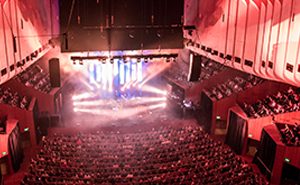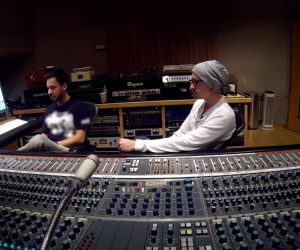
Jeremy Ireland: Reality TV Sound Recordist
Recording location sound is a tough gig. And recording location sound for Reality TV is even tougher. Sand, rain, seawater, hissy fits, 50° heat… Jeremy Ireland has seen it all on gigs like Outback Jack, My Restaurant Rules and, the reality show that started it all, Survivor.
Reality TV is big, especially in the US. Over 20 million people at a time can routinely sit down and perv at the travails of the latest Reality lab rats.
What they won’t think about is the hell the audio and video crews have to go through to deliver this fly-on-the-coconut footage. Whether it’s the jungles of Guatemala, the outback of Australia, or the steamy kitchen of some restaurant, these are very testing environments to get quality sound. And this isn’t the movies… you can’t just call in some ‘evicted’ contestant to provide ADR (Automatic Dialogue Replacement) after the fact. It’s a one-take job. “Get it, or you don’t have it”, as Jeremy Ireland would say.
Jeremy started his professional life enjoying music, playing in bands, recording… the usual stuff. That was until he was invited by a mate to record sound for a short film. He said ‘yes’, and you could say it was a decision that changed his life. Now with two Emmy Award nominations (for ‘Outstanding Sound Mixing for Non-Fiction Programming’), and holding down the job of Survivor’s Head of Audio Department, Jeremy is one of the world’s pre-eminent ‘go-to’ men of Reality TV sound.
Jeremy Ireland: When I got my first gig as a sound recordist I didn’t even know what one was. I mean, you see these guys running around with big fluffy boom poles, but you don’t really take much notice of them – you don’t know what they’re really doing. But I thought, yeah, I’ll give it a go… and I loved it.
Brad Watts: Is it the adrenalin rush that’s addictive? That seat of the pants aspect to it?
JI: Well, there is that pressure. You’ve got to deal with the elements and it’s always a constant struggle to get a clean sound on location – particularly outdoors.
BW: It sounds stressful. You must keep yourself in a constant state of ‘all hands on deck’.
JI: Well, every second costs a lot of money, so every time you say, ‘Can we just wait for that train to go past?’ another astronomical figure has been spent. Film folk generally don’t enjoy waiting around for the sound crew. So while it’s challenging and often very frustrating, the rewards are definitely worth it.
HARSH REALITY
BW: What are the peculiar challenges in working on reality TV as opposed to regular film and television jobs?
JI: In film and TV, you get a Take 2, often a Take 3, Take 4, and sometimes a Take 50, and if you still don’t get it right in 50 takes then you can always just replace it later on. But with Reality TV you have to get it first time, every time, because there is no ‘Take 2’. You can’t get these people to come in and re-voice what they said on the beach that day. It’s just impossible.
Next, there’s no script to follow and no way of delaying the action – Reality TV is about what’s happening now regardless of how much noise is around.
BW: So how does it work? Is it a case of shooting and recording everything that moves, and sifting through it later?
JI: That’s right. You need to record all the time. It’s a very laborious process. So a lot of what you record will never ever see the light of day because the shooting ratios are so high, but you’ve got to nail the sound for what has been selected.
BW: Tell me more about recording on location. You must end up in some incredibly difficult environments.
JI: Sure. Torrential rain, 99% humidity, 50° heat…
BW: Your gear must take a pounding!
JI: It does. Sand is the worst. Sand and salt water is a terrible combination for any piece of gear. You can imagine sand getting in those recording devices, if you get just one speck of sand on a digital head…
BW: What about surf noise?
JI: Shooting around surf is really, really difficult. Your boom mic techniques have to be great and you’ve got to use very directional shotgun mics – pointing away from the surf as much as you can. I’ll then roll it off at a 140Hz. That way you’re losing all that bottom-end rumble, but you still get the high-end stuff, which is very difficult to lose.

BW: What are you using to record?
JI: The show is shot on Digi-Betacam, so a backup mix of the sound gets recorded to camera, while all the individual tracks get recorded discretely onto Tascam DA78 [eight-track digital tape recorder].
BW: Not hard disk then?
JI: My attitude is when you’re recording 24 hours a day, you’re going to run out of hard drives. And having a truckload of hard drives hanging around doesn’t appeal to me. So you just slot in a two-hour tape, hit Record and when it stops, you eject it and throw in another one.
Plus, I’m amazed at how robust the DA78 is. Although it’s designed for studio work I’m using them out on the beach with wind and salt water pelting them, and they just keep going, they actually work! And I’m running them off battery power as well. A DA78 only draws 34W of power, which means we can run it out in the field, through an inverter for hours and hours, off 12V power.
BW: What about the new generation of DVD field recorders? Do they appeal?
JI: Fostex has got its PD6, which I’ve looked into. It’s a six-track location recorder that uses DVD-RAM. And that unit is really, really heavily geared towards location work – it runs off a 12V battery, and it’s built like a black box recorder. The Fostex DV-824 eight-track DVD-RAM recorder (only 2U, and runs off 12V power) is also something I’m looking at. I won’t use the DA78s for much longer now that the DVDs are starting to take off.
BW: In the meantime, how many DA78s do you run?
JI: I’ll often be running two of them out in the field. We isolate as much audio as we can, so I’m often recording discrete tracks in the field. Often it’ll be up to 20 tracks at the same time.
BW: How does that add up with two DA78s?
JI: It’ll be two DA78s (which is 16 tracks), and then I’ll be running two DAT recorders – that’s 20. Plus we’ve got all the camera tracks as well, so it’s huge… it’s no secret in Reality TV that you isolate as much audio as you can, so the editors can then go through and just get that person’s microphone.
BW: Is everyone individually captured on radio mics?
JI: Not always. And it’s not hard to work out when there are radio mics involved, and when there aren’t. But either way – radio mics or booms – the goal is to isolate as many microphones as you can on tape.
BW: What’s your view on recording levels? How hard do you hit the digital medium?
JI: Digital’s kind of weird, because people think, ‘don’t go over –20, because it’s digital and you don’t have to’. But don’t be frightened to crank it. I mean you don’t want to be slamming it at 0dBFS, but if it’s getting up to –4 or –2dB, don’t be frightened of that, it’s still fine.
On a related subject: calibration of your gear is critical – make sure what’s coming in is calibrated all the way through to what’s going onto tape.
There is no ‘Take Two’. You can’t get these people to come in and re-voice what they said on the beach that day. It’s just impossible.
LOCATION CRASH CART
BW: How have you got your gear prepped up?
JI: Basically, all we do is throw it on a trolley, and we put a space blanket around the whole thing.
BW: What’s a space blanket?
JI: A space blanket is one of those emergency blankets for people in shock or with hypothermia. It’s got a reflective surface on one side and a non-reflective on the other. So, depending on which way you turn it out, it can reflect heat, or keep heat in. So what we do is clip those around the trolley – with the mixer, recorders, and the power supply down the bottom – and just encase the whole setup. And then I’ve got a cloth which I throw over my head so I can see the meters on the machines.
BW: Yeah, right. I suppose that would be an issue in bright light.
JI: It’s studio gear so it’s really difficult to see the meters in daylight, so I’ve got to throw a cloth over my head to block out the sunlight. Which means I’m mixing totally blind – I’m not watching the action at all, I’m just watching the meters and listening.
BW: What mixer do you use?
JI: I run two Allen & Heath mixers: a 14-channel Wizard, and a 32-channel GL2200. I own those personally.
BW: How have they fared?
JI: The A&H Wizard has been to hell and back. I’ve taken it apart maybe six or seven times, but I can’t fault it, it’s been amazing.
BW: When you say ‘taken apart’, do you mean drying it out?
JI: What happens is that the corrosion tends to build up inside these things from the salt air. So after a while I can actually hear it start to get crunchy – you can hear the resistors, and the guts of the machine complaining.
BW: So it’s at that point that you know it has to go into surgery?
JI: Often you can just give it a huge whack of level and it sort of clears it throat and comes good. But, yeah, as it gets worse you’ve got to pull it apart and clean it.
BW: How do you clean it?
JI: We use an anti-corrosion spray (that I don’t think you can get in Australia) called Redox. It just goes against every instinct: you just coat all the insides of the mixer with this stuff until it’s totally soaked. Then you get a toothbrush and just scrub the hell out of everything. You’re literally cleaning it; scrubbing off all the corrosion inside it. Then you leave it open in the office to dry out, and it comes good.


MICROPHONES
BW: What mics do you use?
JI: A lot of sound gear made for film and television you’ll never, ever find in your local music shop. It’s usually very expensive. I own and prefer to use Lectrosonics radio mics. As I say, they’re expensive, but they’re bullet proof – you can drop it off of a building onto a carpark and it’ll be working the next day, fine… you can submerge it in fresh water and it’ll dry out and work the next day.
BW: And what shotgun mics do you use?
JI: Sennheisers. It’s all Sennheiser mics; they’re seen as industry standard.
BW: What are the least friendly conditions for microphones would you say?
JI: Shooting in the rain is always hard.
BW: Because of the noise?
JI: No, because of the damp. This equipment will stand a certain amount of rain, and then it just gets wet – electricity and water don’t really mix. So you tend to find that if you do get caught in a sudden torrential downpour, the gear will stop. You’ve got to keep your gear covered, keep it dry, and with the shotgun mics we generally use fluffy windsocks.
BW: They help with rain as well as wind noise?
JI: They can actually absorb quite a lot of moisture before it starts to get inside that blimp and affect the microphone. They’re amazing.
BW: What’s the biggest stuff-up you’ve ever made on location.
JI: The classic one involved recording with a DA78. There’s no confidence monitoring with a DA78; in other words you can’t listen to what’s actually being recorded off the tape head, which is obviously a drawback. You can on the DA98, but we don’t use those in the field. Anyway, on this occasion it was all sounding great, and I kept noticing this little display blinking the letters ‘EOT’. I wasn’t too fussed, I could see that the red lights were on and, as I say, it was all sounding good. After a while I’m thinking, ‘what the hell is EOT?’, and then it suddenly dawned on me: End Of Tape! I thought I’d put in a one-hour tape, but in fact I’d only put in a 30-minute tape.
BW: Which goes to demonstrate that whole ‘no second take’ pressure doesn’t it?
JI: Yeah, that and needing to have a backup. You’ve got to cover your arse.
















RESPONSES